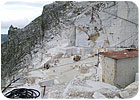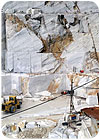
The Cervaiole Quarry sits approximately 5,000 feet above sea level in the Apuan Alps near Carrara, Italy.
Although virtually all of the quarries for Carrara White marble in the Apuan Alps keep themselves well connected with the material’s long and venerable history, the Cervaiole Quarry site stands apart from many of its counterparts. The quarry sits upon Mount Altissimo, one of the most celebrated peaks in the Apuan mountain range, and it has a well-documented history that dates back for centuries.
The quarry has been operated by Henraux since 1821, and the company name is even noted on the CAI mountaineering club’s maps of the region. According to local historians, the quarry dates back to the Roman Age, and Michelangelo was said to have selected marble blocks from the site for use on Florence’s San Lorenzo Church, an ambitious project that was ultimately aborted. It is also reported that Michelangelo designed the road that leads from sea level -- where the cities of Pietrasanta and Forte dei Marmi lie -- to the quarry, and that some of these roads are still in use today.
And while there has been some debate as to which of the Carrara White quarries were actually utilized by Michelangelo and to what extent, there is no debate as to the rich history of the Cervaiole site and Henraux’s involvement with the quarry. In 1821, Jean Baptiste Henraux, a Frenchman that has been cited as a lieutenant of Napoleon Bonaparte, traveled to the Carrara region following the end of the Napoleonic Wars, and he founded the company that still bears his name today. He quickly reopened the Altissimo quarries, which had been closed during the war, and it was used for prominent architectural works within Italy as well as other points in Europe.
The use of stone from the Cervaiole Quarry continued throughout the 20th century, and during the early 1990s, the marble was used for enormous mosque projects in the cities of Mecca and Medina, Saudi Arabia. The magnitude of these stone projects was unprecedented at the time, and both mosques remain among the most noteworthy stone structures in the world.
The Henraux company is now headed by Paulo Carli, whose family has a long history in the stone industry, and the ownership has made improvements in the quarries as well as the stoneworking facilities.

Stone is extracted using Fantini chainsaws, along with heavy equipment for maneuvering.
Current operations
Today, the Cervaiole Quarry produces several white marble varieties as well as a gray variety. Approximately 70% of the white material is Arabescato, while the remaining 30% is chiefly comprised of Statuario and Venatino. The gray stone is sold as Bardiglio marble, and it is commonly used for countertops, columns and borders.The quarry produces 20,000 to 25,000 tons of useable stone per year, equivalent to approximately 10,000 cubic meters. Typical blocks are 6.5 x 4 x 3.5 to 4 meters in size.
The quarry employs a total of 20 workers, and it operates a single eight-hour shift. Stone is extracted using Fantini chainsaws, along with heavy equipment for maneuvering. Diamond wire saws are used for block trimming and cutting large faces within the quarry.